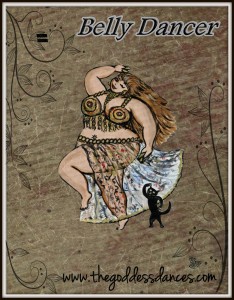

The term “belly dance” is from the French description “danse du ventre” or dance of the belly. While belly dancing certainly involves the whole body, there is a noticeable emphasis on movements of the hip and pelvic area.
I consider Fusion-Style, which utilizes a wide range of elements from other dance forms, to be the style that lends itself to merging into contemporary exotic dance. Many traditional belly dancers, however, will prefer to keep their form of dance isolated from the contemporary and very “sexed-up” aspect of exotic dance. I can certainly respect that.
Belly dance, however, is an ancient and widespread folk art that has certainly influenced and gotten intermingled with the notions of exotic dance. For those of us who like to draw up it for inspiration, we would do well to clarify our use of some of it’s movements as “contemporary” and “fusion-style”.
It is widely suggested that modern belly dance might actually be traced back to rituals of fertility and childbirth. Belly dance is certainly most recognizable and characterized by the combination of sharply defined muscular abdominal contractions as well as smooth undulations that both mimic and help to condition the body for labor and delivery.
One can easily imagine early pagans worshiping a mother Goddess, back when the mysteries of life and death were more magically intertwined within women’s bodies. Many contemporary belly dancers find that imagining to be an empowering spiritual aspect that gives a sacred grounding to their lives as women and as dancers.
Variations of what can be called belly dance are found in numerous places in the ancient world and it is suggested that travelers and traders help to spread the art form and lend it its variations in movement, music and costuming.
Arabic terms commonly used in the world of belly dance. Some words can have more than one meaning, however, and cause some confusion. For example “beladi” can be spelled in different ways and can refer to a kind of dress, a style of folkloric dance, and is also the name of a drum rhythm.
I recommend a good glossary for further reading.
Although its exact origins are disputed among scholars, (and I’m hardly qualified to make a definitive claim), belly dance is generally considered to be an ancient dance that evolved from various dance traditions throughout the Middle East and Northern Africa.
Aside from the possible expression as a sacred dance of childbirth instruction, belly dance also appears to have been very much a social activity. Women danced for each other and both sexes performed at celebrations or weddings and such.
The advent of colonialism romanticized all foreign cultures as inherently intriguing, and it was probably inevitable that belly dance be discovered and celebrated for it’s exotic flair. In 1893 a dancer named “Little Egypt” caused an enormous stir at The Chicago World Fair.
The rest, as they say, is history.
While belly dancing was influenced by a variety of factors in the ancient world, contemporary styles continue the tradition of introducing new elements into the foundational repertoire of movement. Fusion-Style belly dance certainly falls into this ongoing contemporary influence.
There are currently a number of styles that can be roughly grouped; traditional or folkloric styles, Cabaret (the style most recognizable by Western audiences), American Tribal Style or ATS, and Contemporary Fusion Styles.
Today belly dance is enjoyed by thousands all over the world. And like everything else, it will continue to evolve and change over time.
As a contemporary exotic dance form, the term fusion means that we celebrate any flavor here at The Goddess Dances. I just call it Belly-Fusion!
A Good Scholarly Source On Origins
www.bellydancedivas.co.za has good info about belly dance and its origins